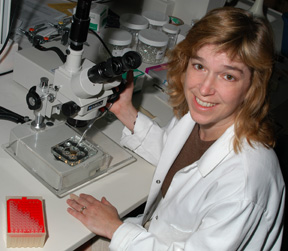 |
Gloria Borgstahl, Ph.D. Photo by Biomedical Communications. |
Gloria Borgstahl, Ph.D., is interested in far more than diamonds.
From her 10th floor lab in the Lied Transplant Center, the petite crystallographer analyzes crystals, typically the size of a grain of sand, to map the structure of human proteins.
Her goal: To better understand the structure and function of proteins involved in DNA repair and to help other scientists apply structural biology to their science in order to control and treat a variety of diseases including cancer.
“It’s similar to fixing a car,” said Dr. Borgstahl, an associate professor in the Eppley Institute for Research in Cancer and Allied Diseases. “You first need to know what the engine looks like. Here, we need to visualize the molecules.”
Crystallography: What is it?
Crystallography — the study of the atomic structures of proteins by growing crystals of the protein and then collecting X-ray diffraction data — has existed for decades. But, Dr. Borgstahl is one of the few X-ray crystallographers with the background and ability to solve problems relevant to the interaction of cancer cells with anti-cancer agents.
“It’s exciting to look at a structure no one has ever seen before,” Dr. Borgstahl said. “It’s like being an explorer — the discovery process is most rewarding.”
Strengthening UNMC’s research effort
“Dr. Borgstahl is a perfect addition to the cancer center and UNMC,” said Ken Cowan, M.D., Ph.D., director of the UNMC Eppley Cancer Center. “She adds specific expertise in X-ray crystallography, which is a critical addition to our structural biology program.”
Understanding the structure of key proteins in cancer is essential in developing specific therapies for each cancer, Dr. Cowan said. “UNMC and the Eppley Cancer Center research effort are definitely strengthened by the addition of Dr. Borgstahl,” he said.
Recruited with tobacco settlement funds
Dr. Borgstahl, who joined the UNMC faculty in August, also is among a handful of researchers recently recruited through the tobacco settlement funds that the Nebraska Legislature allocated to the state’s four biomedical research institutions — UNMC, the University of Nebraska-Lincoln, Creighton University and Boys Town National Research Hospital. In 2001-2002, the Legislature allocated nearly $5 million to the UNMC Tobacco Settlement Biomedical Research Development Fund.
|
|
“This is my ideal job,” Dr. Borgstahl said. “It’s close to home and research is my first love. This is a perfect fit for me.”
The road to Omaha
A native of Dubuque, Iowa, Dr. Borgstahl attended the University of Iowa, where she earned degrees in biomedical engineering and biochemistry and crystallography. She did her post-doctoral work in protein crystallography at The Scripps Research Institute in La Jolla, Calif., and in molecular biology at Los Alamos National Laboratory in Los Alamos, N.M.
In 1996, Dr. Borgstahl worked at the University of Toledo department of chemistry, where she studied the macromolecules essential to the maintenance and replication of DNA. While there, she began working with NASA as a ground investigator and had experiments flown to the International Space Station’s Destiny laboratory.
Dr. Borgstahl’s experiments take flight
The recent return of the shuttle brought back one of Dr. Borgstahl’s experiments – growing 133 separate crystallization experiments in space. Crystals grown in microgravity are larger and physically more perfect than those on the ground, she said. To invoke the crystallization process in space, Dr. Borgstahl prepared the purified protein and a second formula of buffers and salts.
The crystals, which will take several months to evaluate, will be photographed under a microscope and exposed to X-rays in the Lied Transplant Center. Then, a complete evaluation of crystal quality, compared to Earth-grown controls, will be done with a synchotron, which provides a brilliant and adjustable X-ray beam, called the National Synchrotron Light Source or NSLS at Brookhaven National Laboratory in Upton, New York.
“From the diffraction of the X-ray we can see the protein’s structure,” said Dr. Borgstahl, the youngest of seven children. “The crystal serves as an amplifier for the diffraction signal from which the atomic structure is deduced.”
The information, which includes analyzing mathematical equations, helps Dr. Borgstahl determine the three dimensional layout of the atoms and the overall shape of the macromolecule.
Outside the lab
Outside the lab, she and her husband, Daniel Kramer, enjoy spending time with their two children, Marguerite and John.